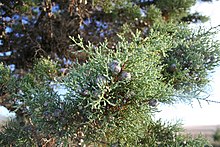Scaled cypresses
| Scaled cypresses | ||||||||||||
|---|---|---|---|---|---|---|---|---|---|---|---|---|

Cones of Actinostrobus pyramidalis |
||||||||||||
| Systematics | ||||||||||||
|
||||||||||||
| Scientific name | ||||||||||||
| Actinostrobus | ||||||||||||
| Miq. |
The actinostrobus ( Actinostrobus ) are a genus of trees in the family of the cypress family (Cupressaceae). The three species of the genus live in a narrow band along the west coast of Australia.
description
Scaled cypresses are evergreen , monoecious shrubs or trees with a smooth, thin, flaking bark . The branches are short and firm and form a conical or shrub-like crown. Trees with a drooping crown also occur naturally.
The leaves are about three in whorls. Young leaves on young trees grow needle-shaped. The fully grown green or glaucous green leaves are usually shorter than 5 mm, have a linear-lanceolate shape and are spiky-pointed. The underside of the leaf is keeled, the leaf edge serrated. On both sides of the leaf there are two bands with stomata .
The pollen cones are small and cylindrical. The 10 to 18 microsporophylls are in threefold whorls and have 2 to 4 abaxial pollen sacs . The seed cones stand individually, in groups of two to three or heaped along branches. When closed, they are roughly spherical with a hemispherical tip or spherical-conical. The cone scales are arranged in two whorls, each with three scales of equal size. The ovules stand upright in the armpits of the cone scales. At the base of the cones there are 9 to 15 thin, sterile scales that fit snugly against the cone. 9 to 12 three-winged seeds are formed per cone. The seedlings form two cotyledons .
The number of chromosomes is .
Distribution and ecology
The distribution area extends in a narrow band along the west coast of Australia from the south of Shark Bay to Albany . The species Actinostrobus pyramidalis and Actinostrobus arenarius are often found together with the ornamental cypress ( Callitris preissii ). Representatives of the two genera ( Actinostrobus and Callitris ) are the only representatives of the conifers to colonize dry areas in Australia, so they occupy ecological niches similar to those of the juniper ( Juniperus ) in the northern hemisphere.
Systematics
The actinostrobus ( Actinostrobus ) are a genus in the family of cypress plants (Cupressaceae). Three species are assigned to the genus. Some authors also place them in the genus Callitris :
- Actinostrobus acuminatus Parl. (Syn .: Callitris acuminata (Parl.) F.Muell. ): Older plants show both young, needle-shaped and older, scale-like leaves. Seed cones do not grow in groups.
- Actinostrobus arenarius C. A. Gardner (Syn .: Callitris arenaria (CAGardner) JEPiggin & JJBruhl ): Older plants only have scale-shaped leaves, cones also grow in groups, the cone seed scales have a straight and pointed end.
- Actinostrobus pyramidalis Miq. (Syn .: Callitris pyramidalis (Miq.) JEPiggin & JJBruhl ): Older plants only have scale-shaped leaves, cones also grow in groups, the cones' seed scales have a rolled up and blunt end.
The genus was first described in 1845 by Friedrich Anton Wilhelm Miquel in Plantae Preissianae . The generic name is derived from the Greek, actino stands for "(light) beam" and strobus for "cone". The name refers to the six cone scales that converge at the cone tip.
use
No use is known for any of the species, they are also rarely used as ornamental plants, although they have some ornamental value due to their conical shape, green color and cone shape.
proof
literature
- Aljos Farjon: A Handbook of the World's Conifers . Brill, Leiden-Boston 2010, ISBN 90-04-17718-3 , pp. 132 .
- Schütt, Schuck, Stimm: Lexicon of tree and shrub species . Nikol, Hamburg 2002, ISBN 3-933203-53-8 , pp. 29 .
- Johann Georg Christian Lehmann (Ed.): Plantae Preissianae sive Enumeratio plantarum quas in Australasia occidentali et meridionali-occidentali annis 1838-1841 . Hamburg 1845, p. 644 .
Individual evidence
- ^ German name after Schütt et al .: Lexicon of Tree and Shrub Species, p. 29
- ↑ a b c d e f Farjon: A Handbook of the World's Conifers , Volume 1, p. 132
- ^ Armin Jagel, Veit Dörken: Morphology and morphogenesis of the seed cones of the Cupressaceae - part III. Callitroideae . Bulletin of the Cupressus Conservation Project, Vol. 4 (3), 2015, pp. 91-103 ( PDF )
- ↑ a b Actinostrobus. In: The Gymnosperm Database. Christopher J. Earle, April 11, 2011, accessed December 18, 2011 .
- ↑ Rafaël Govaerts (ed.): Sctinostrobus. In: World Checklist of Selected Plant Families (WCSP) - The Board of Trustees of the Royal Botanic Gardens, Kew . Retrieved March 19, 2019.
- ^ Actinostrobus. In: Germplasm Resources Information Network (GRIN). United States Department of Agriculture, accessed December 18, 2011 .
- ↑ Plantae Preissianae, p. 644, online
- ↑ Actinostrobus Miq. In: The International Plant Name Index. The Plant Name Project, accessed December 18, 2011 .
- ↑ Farjon: A Handbook of the World's Conifers , Description of the Individual Species, Volume 1, pp. 132-135
Web links
- KD Hill: Actinostrobus. Australian National Botanic Gardens, accessed December 18, 2011 .
- Michael P. Frankis: Southern Cupressaceae. In: Michael P. Frankis Cone Collection. Arboretum de Villardebelle, 2003, accessed December 18, 2011 (English, with photos of the cones).
- Actinostrobus. HerbiGuide, accessed on December 18, 2011 (English, with distributionmaps).
- Jean and Fred Hort: Actinostrobus pyramidalis. flickr, accessed December 19, 2011 (photos by Actinostrobus pyramidalis ).

